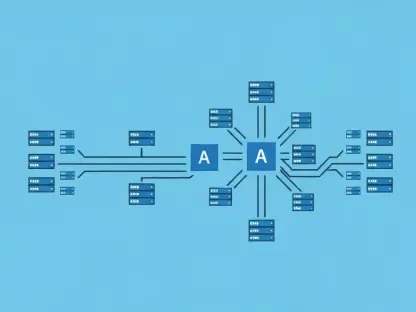The 2024 Flexera State of the Cloud Report unveils ongoing hurdles organizations face in managing cloud costs, despite widespread FinOps adoption. Gathered from over 750 technical professionals and leaders globally, the data sheds light on key areas from cloud expenditure challenges to generative AI trends.
Persistent Cloud Cost Management Challenges
Cloud cost management remains a significant pain point for organizations, with 84% of respondents citing it as their top cloud-related challenge. This concern mirrors findings from previous years, indicating persistent issues in effectively controlling cloud spending. The costs associated with cloud services can escalate rapidly, often outpacing initial budget forecasts and leaving organizations scrambling to rebalance their financial strategies. Ineffective management of cloud costs can result in unanticipated financial burdens, leading to budget overruns and curtailing the potential benefits associated with cloud adoption.
The consistent identification of cloud cost management as a major issue underscores the necessity for ongoing vigilance and improved strategies in financial governance. To combat these challenges, organizations need to enhance their visibility into cloud expenditures, employing advanced monitoring and optimization tools to track and manage spending more effectively. Regularly auditing cloud usage and expenditures can help predict future costs and identify areas where savings might be achieved. The dynamic nature of cloud services necessitates a proactive and informed approach to ensure financial prudence and sustainability.
The Rise of FinOps Teams
Growing Recognition and Presence
A notable trend identified in the report is the rise of FinOps teams within organizations. An increase from 51% in 2024 to 59% in this year’s report highlights growing recognition of the necessity for dedicated financial and operational management of cloud resources. FinOps, an amalgamation of finance and operations, emphasizes the development of processes that promote the efficient and effective use of cloud services. These teams work to bridge the gap between financial strategy and cloud operation, ensuring that expenditures align closely with organizational budgets and objectives.
FinOps not only boosts visibility and accountability regarding cloud expenses but also emphasizes the importance of stakeholder collaboration and executive backing for successful implementation. Executive sponsorship and cross-functional collaboration are crucial for the efficient functioning of FinOps teams. This integrated approach allows organizations to allocate their cloud resources more strategically, ensuring that initiative costs are monitored regularly and aligned with business goals. FinOps teams also enable the adoption of best practices, promoting a culture of cost consciousness and continuous improvement.
Enhanced Visibility and Accountability
By establishing clear governance frameworks and leveraging advanced financial management tools, FinOps teams enhance visibility into cloud spending. These teams employ detailed analytics and reporting mechanisms that provide real-time insights into cloud expenditures, aiding in the early detection and rectification of financial discrepancies. The deployment of predictive analytics supports the accurate forecasting of future cloud costs, enabling organizations to plan and allocate resources more efficiently. FinOps teams also advocate for the implementation and adherence to usage policies designed to curb unnecessary expenditure.
Moreover, the importance of stakeholder involvement and executive sponsorship cannot be overstated. These elements are critical for the effective operation and motivation of FinOps teams. High-level engagement ensures that the financial management of cloud resources receives the necessary attention and support, fostering a culture of accountability and financial diligence. Consequently, organizations can realize significant cost savings and improved operational efficiency, enhancing their overall cloud strategy and supporting their long-term business objectives.
Embracing Generative AI (GenAI)
Widespread AI Adoption
Generative AI has become a focal point for many organizations, with 72% utilizing GenAI services in various capacities. Approximately half of the respondents leverage these services via public cloud platforms, underscoring the growing reliance on cloud-based AI solutions. The adoption of Generative AI encompasses a wide array of applications, from automating content creation and enhancing customer interactions to performing complex data analysis. The transformative potential of AI within cloud infrastructures promises to drive organizational innovation and efficiency.
Despite the enthusiasm for AI adoption, many organizations continue exploring effective means of integrating generative AI within their cloud infrastructures, emphasizing the transformative potential of AI in modern cloud architectures. Integrating AI with existing cloud setups poses unique challenges, including the need for scalable data management solutions and advanced security mechanisms to protect sensitive information. Consequently, organizations are investing in expanding their cloud capabilities, including the use of sophisticated data warehouses to support the influx of AI-driven tasks.
Integrating AI within Cloud Architectures
The integration of generative AI within cloud infrastructures necessitates significant architectural modifications to accommodate AI workloads efficiently. This includes enhancing cloud storage capacities, optimizing data transfer mechanisms, and ensuring robust computation power to handle complex AI algorithms. Additionally, organizations must address potential cybersecurity threats by implementing multi-layered security frameworks and stringent access controls. As a result, the use of AI in cloud environments is accelerating the evolution of cloud architectures, driving the development of more resilient and adaptable infrastructure models.
The adaptation of data warehouses to support AI services is particularly notable. Data warehouses offer the robust storage and quick retrieval capabilities required for processing large datasets, which are integral to AI operations. Organizations are also increasingly leveraging serverless architectures and cloud-native services designed to support dynamic scaling and efficient resource utilization. Overall, the integration of generative AI into cloud systems reflects a strategic shift towards embracing advanced technologies to enhance organizational agility, innovation, and competitiveness.
The Trend of Minimal Cloud Workload Repatriation
Limited Repatriation Activities
Contrary to the notion of a large-scale movement back to on-premises environments, only 21% of workloads have been repatriated. Many initial cloud migrations were hasty and lacked proper refactoring, leading organizations to reconsider the true cost-benefit of repatriation efforts. Early stage “lift-and-shift” migrations often prioritized speed over optimization, resulting in suboptimal performance and increased costs. Organizations now face the complex decision of whether to refactor these workloads for better efficiency within the cloud or to repatriate them to on-premises environments.
Performance needs also influence these decisions, as certain bespoke requirements are more efficiently met in well-tuned on-premises setups rather than incurring high costs in the cloud. Specific workloads that demand high-performance computing or low-latency operations may benefit from optimized on-premises infrastructures designed to meet these exacting requirements. This selective approach to workload management highlights the nuanced considerations organizations must ponder when balancing cost and performance.
Evaluating Cost-Benefit Balance
The decision to repatriate cloud workloads involves a careful evaluation of the cost-benefit balance. Organizations must assess the long-term operational costs and potential performance gains of refactoring workloads for the cloud against the immediate and ongoing expenses of maintaining on-premises environments. This process often reveals that, while repatriation might offer performance advantages for specialized tasks, the flexibility and scalability of cloud services still present compelling advantages for a wide range of applications.
Moreover, the iterative nature of cloud cost management means that continuous monitoring and re-evaluation are necessary. As cloud service providers enhance their offerings and adjust pricing models, organizations might find improved cost efficiencies within the cloud, making repatriation less attractive. Therefore, the current trend of minimal cloud workload repatriation is likely to persist as organizations strive to optimize their cloud strategies and extract maximum value from their cloud investments.
Striking a Balance Between Cost and Sustainability
Financial Imperatives Over Sustainability
The report highlights the persistent tension between cost optimization and sustainability efforts. While sustainability is gaining importance due to increasing mandates, 57% of organizations prioritize cost optimization. This trend reflects the overriding influence of financial considerations over sustainability goals, particularly when there is a lack of substantial financial penalties for not meeting environmental targets. In a business environment where fiscal prudence often dictates strategic decisions, organizations tend to focus on immediate cost savings rather than longer-term environmental benefits.
However, this approach does not diminish the significance of sustainability initiatives. The increasing regulatory landscape and growing stakeholder awareness underscore the importance of integrating sustainable practices into cloud operations. Organizations must strike a delicate balance, ensuring they do not compromise financial goals while making concerted efforts to align with sustainability mandates. This dual focus requires innovative solutions and strategic planning to achieve both cost efficiency and environmental responsibility.
Integrating Sustainable Practices
Organizations are increasingly recognizing that sustainable practices can align with financial goals, particularly when viewed through the lens of long-term cost savings and risk mitigation. Sustainable cloud management involves optimizing energy usage, leveraging renewable energy sources, and adopting carbon offset strategies. These practices not only reduce the environmental footprint but can also lead to lower operational costs. For instance, energy-efficient data centers and optimized workload distributions can yield significant cost savings over time.
Fostering a culture of sustainability involves engaging stakeholders at all levels and embedding environmental considerations into the core financial and operational strategies. This integration often necessitates a collaborative approach, where sustainability teams work closely with FinOps and other departments to ensure a holistic and balanced strategy. By doing so, organizations can achieve a symbiotic relationship between cost optimization and sustainability, fostering both financial health and environmental stewardship.
Navigating the Evolving Cloud Landscape
The 2024 Flexera State of the Cloud Report highlights persistent challenges organizations face in managing cloud costs, despite the widespread adoption of FinOps practices. This report, which collects insights from over 750 technical professionals and leaders around the world, delves into various critical areas, including difficulties in controlling cloud spending and emerging trends in generative AI. These insights provide a comprehensive overview of the current cloud computing landscape, emphasizing the importance of effective cost management and the growing influence of AI technologies. The findings suggest that while FinOps is gaining traction, many companies still struggle with optimizing their cloud expenditures and harnessing the full potential of advanced AI tools. Overall, the report underscores the complexity of cloud cost management and the need for continued innovation and strategic planning to navigate this ever-evolving domain effectively.









